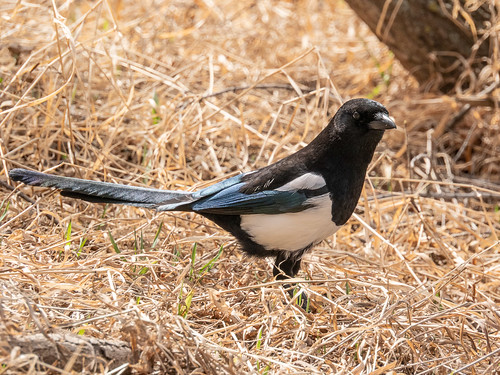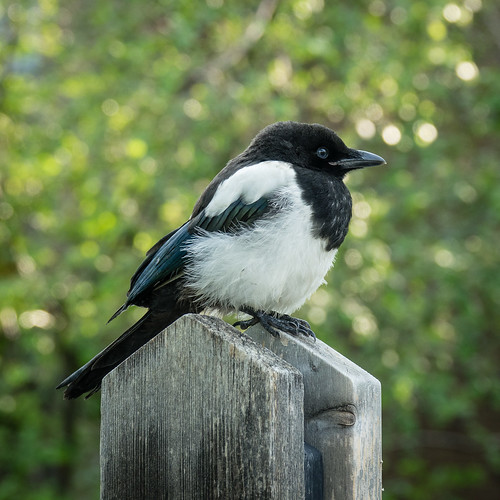Western Canada’s black-billed magpies are one of 17 different species of magpies around the world. They are almost identical to Eurasian magpies. However, magpies found in South and East Asia have vivid blue and green feathers.
“In ancient Rome, the magpie was associated with magic and fortune telling, while in Scandinavia some witches rode magpies or turned into them. In Germany, the bird was considered a bird of the underworld and in Scotland it was said that magpies had a drop of the devil’s blood on their tongues."Outside of Europe, the magpie has a much more positive image. In Native American legends, the magpie was considered a friend of hunter-gatherer tribes. In Korea, the magpie is thought to bring good news and in China it is a symbol of happiness, foretelling and good fortune.” [Horniman Museum & Gardens]
Magpies are omnivorous, eating everything from insects, grains, and berries to small rodents, other birds’ eggs, and even young chicks (although eggs and chicks make up only a very small portion of their diet). They’ve adapted well to urban living, helping themselves to leftover food scraps. In rural areas, they pick the ticks from the backs of large mammals such as moose and deer. The ticks they don’t eat immediately are tucked away for future meals. “Most of the ticks, however, are cached alive and unharmed, and may live to reproduce later.”
Magpies belong to the corvid family along with crows, ravens, and jays and are some of the most intelligent birds in the world. Magpies “can use tools, play games, work in teams, and even mimic human speech.”
“One of the most notable Black-billed Magpie behaviors is the so-called ‘funeral’—when one magpie discovers a dead magpie, it begins calling loudly to attract other magpies. The gathering of raucously calling magpies (up to 40 birds have been observed) may last for 10 to 15 minutes before the birds disperse and fly off silently.” [All About Birds]
Unlike other crows, magpies have a very long tail. In fact, it’s the same length as their body. Scientists aren’t sure why they have such a long tail, “but it may provide magpies with the ability to make swift turns while in the air. This would allow the birds to evade larger predators and make up for rather average flying abilities.”
Magpies spend up to 40 days constructing large, solid domed nests roughly 30 inches high and 20 inches wide. They are so well constructed they can last for many years. “The male gathers sticks for the exterior. The female tends to the interior, forming a mud cup and lining it with grass.”
Photographer Ron Dudley has been photographing one nest for over 7 years and shares some of his photographs. [Feathered Photography]
Magpies are vocal, social birds. You’ll often find them sitting in groups calling loudly. A group of magpies is known as a parliament, possibly because they often gather in large groups to converse among themselves. They will also band together to chase away a raptor. In the spring, you may hear large groups of birds cawing loudly as younger birds try to chase away and take over the territory of more established pairs.
“Magpies are very curious, just like their relatives, the jays and crows. They may sometimes pick up shiny things, but they don’t show any preference for shiny over dull. A magpie’s more likely to grab your sandwich than your silver.” [Audubon]
Magpies often perch on poles or the tops of trees to provide a visual display of their territory. The males establish dominance over other males by stretching their neck and flashing their white eyelids. Magpies mate for life. The females initiate the mating display by begging for food from the male. They lay one brood of 1-9 eggs each year. The fledglings learn to fly when they are about a month old but may stay with their parents for a year before flying away to find a mate. Magpies are non-migratory and normally stay within a 10 km radius of where they were born.
Check out EcoFriendly Sask's Nature Companion, a free nature app for Canada's 4 western provinces



